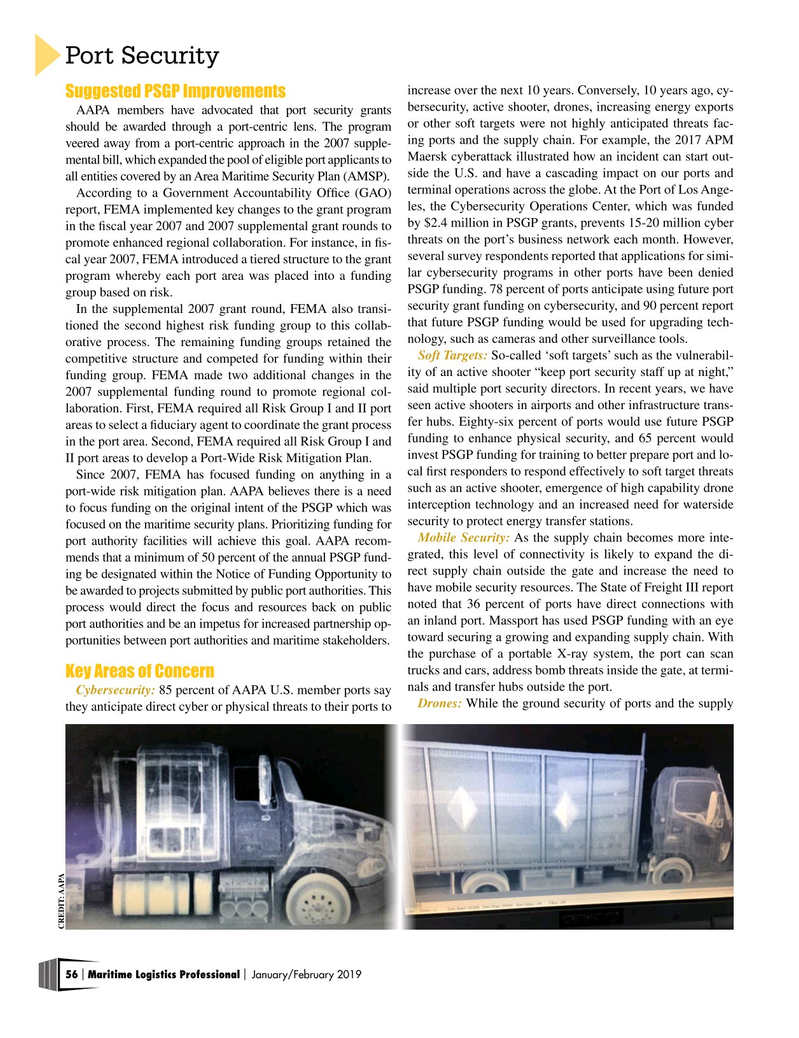
Page 56: of Maritime Logistics Professional Magazine (Jan/Feb 2019)
Cruise Ports Annual
Read this page in Pdf, Flash or Html5 edition of Jan/Feb 2019 Maritime Logistics Professional Magazine
Port Security increase over the next 10 years. Conversely, 10 years ago, cy-
Suggested PSgP Improvements
AAPA members have advocated that port security grants bersecurity, active shooter, drones, increasing energy exports should be awarded through a port-centric lens. The program or other soft targets were not highly anticipated threats fac- ing ports and the supply chain. For example, the 2017 APM veered away from a port-centric approach in the 2007 supple-
Maersk cyberattack illustrated how an incident can start out- mental bill, which expanded the pool of eligible port applicants to side the U.S. and have a cascading impact on our ports and all entities covered by an Area Maritime Security Plan (AMSP).
According to a Government Accountability Offce (GAO) terminal operations across the globe. At the Port of Los Ange- report, FEMA implemented key changes to the grant program les, the Cybersecurity Operations Center, which was funded in the fscal year 2007 and 2007 supplemental grant rounds to by $2.4 million in PSGP grants, prevents 15-20 million cyber threats on the port’s business network each month. However, promote enhanced regional collaboration. For instance, in fs- several survey respondents reported that applications for simi- cal year 2007, FEMA introduced a tiered structure to the grant program whereby each port area was placed into a funding lar cybersecurity programs in other ports have been denied
PSGP funding. 78 percent of ports anticipate using future port group based on risk. security grant funding on cybersecurity, and 90 percent report
In the supplemental 2007 grant round, FEMA also transi- that future PSGP funding would be used for upgrading tech- tioned the second highest risk funding group to this collab- orative process. The remaining funding groups retained the nology, such as cameras and other surveillance tools.
Soft Targets: So-called ‘soft targets’ such as the vulnerabil- competitive structure and competed for funding within their funding group. FEMA made two additional changes in the ity of an active shooter “keep port security staff up at night,” said multiple port security directors. In recent years, we have 2007 supplemental funding round to promote regional col- laboration. First, FEMA required all Risk Group I and II port seen active shooters in airports and other infrastructure trans- fer hubs. Eighty-six percent of ports would use future PSGP areas to select a fduciary agent to coordinate the grant process in the port area. Second, FEMA required all Risk Group I and funding to enhance physical security, and 65 percent would invest PSGP funding for training to better prepare port and lo-
II port areas to develop a Port-Wide Risk Mitigation Plan.
Since 2007, FEMA has focused funding on anything in a cal frst responders to respond effectively to soft target threats port-wide risk mitigation plan. AAPA believes there is a need such as an active shooter, emergence of high capability drone to focus funding on the original intent of the PSGP which was interception technology and an increased need for waterside focused on the maritime security plans. Prioritizing funding for security to protect energy transfer stations.
Mobile Security: As the supply chain becomes more inte- port authority facilities will achieve this goal. AAPA recom- grated, this level of connectivity is likely to expand the di- mends that a minimum of 50 percent of the annual PSGP fund- ing be designated within the Notice of Funding Opportunity to rect supply chain outside the gate and increase the need to have mobile security resources. The State of Freight III report be awarded to projects submitted by public port authorities. This process would direct the focus and resources back on public noted that 36 percent of ports have direct connections with an inland port. Massport has used PSGP funding with an eye port authorities and be an impetus for increased partnership op- toward securing a growing and expanding supply chain. With portunities between port authorities and maritime stakeholders. the purchase of a portable X-ray system, the port can scan trucks and cars, address bomb threats inside the gate, at termi-
Key Areas of Concern
Cybersecurity: 85 percent of AAPA U.S. member ports say nals and transfer hubs outside the port.
Drones: While the ground security of ports and the supply they anticipate direct cyber or physical threats to their ports to
CREDIT: AAPA 56 Maritime Logistics Professional January/February 2019 | |

 55
55

 57
57
